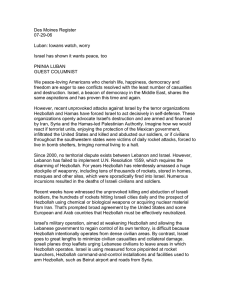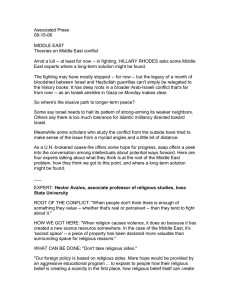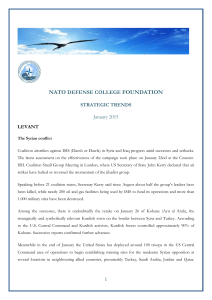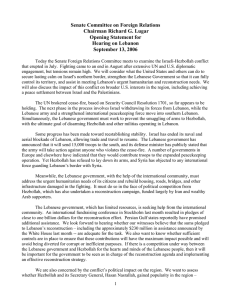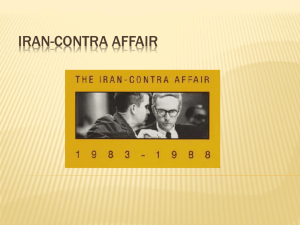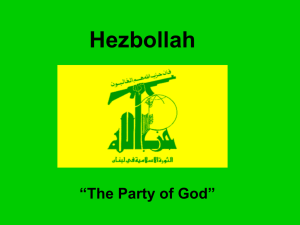The Hezbollah-Israel War: A Preliminary Assessment
advertisement
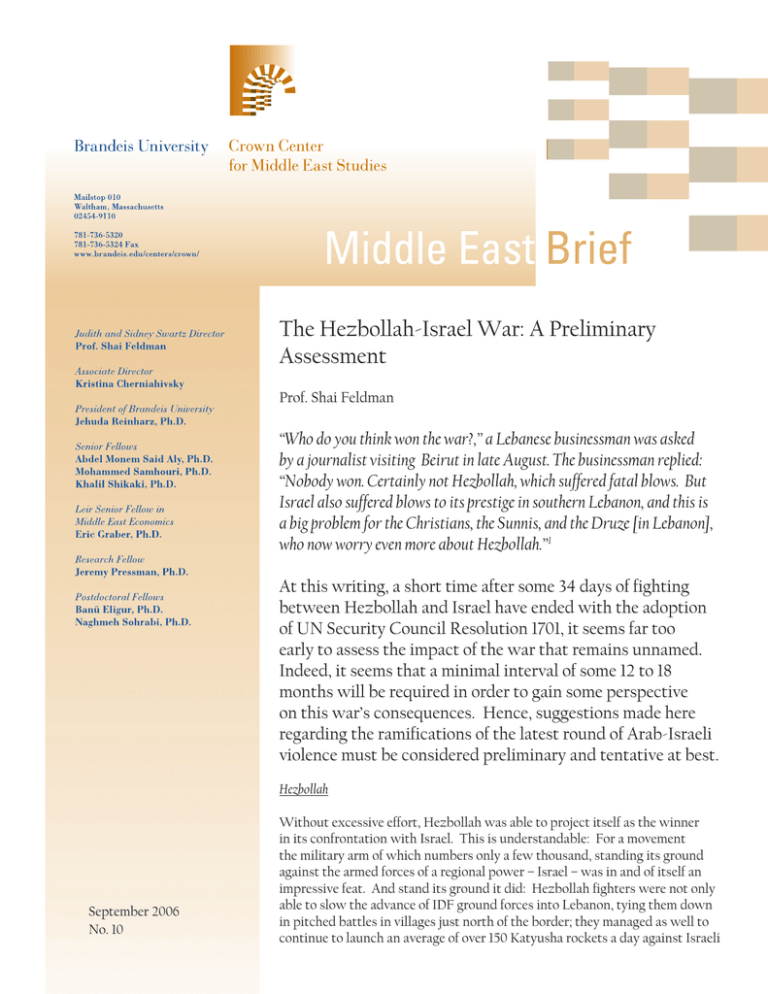
The Hezbollah-Israel War: A Preliminary Assessment Prof. Shai Feldman “Who do you think won the war?,” a Lebanese businessman was asked by a journalist visiting Beirut in late August. The businessman replied: “Nobody won. Certainly not Hezbollah, which suffered fatal blows. But Israel also suffered blows to its prestige in southern Lebanon, and this is a big problem for the Christians, the Sunnis, and the Druze [in Lebanon], who now worry even more about Hezbollah.”1 At this writing, a short time after some 34 days of fighting between Hezbollah and Israel have ended with the adoption of UN Security Council Resolution 1701, it seems far too early to assess the impact of the war that remains unnamed. Indeed, it seems that a minimal interval of some 12 to 18 months will be required in order to gain some perspective on this war’s consequences. Hence, suggestions made here regarding the ramifications of the latest round of Arab-Israeli violence must be considered preliminary and tentative at best. Hezbollah September 2006 No. 10 Without excessive effort, Hezbollah was able to project itself as the winner in its confrontation with Israel. This is understandable: For a movement the military arm of which numbers only a few thousand, standing its ground against the armed forces of a regional power ­– Israel – was in and of itself an impressive feat. And stand its ground it did: Hezbollah fighters were not only able to slow the advance of IDF ground forces into Lebanon, tying them down in pitched battles in villages just north of the border; they managed as well to continue to launch an average of over 150 Katyusha rockets a day against Israeli cities, towns, and villages. Those attacks also succeeded in forcing a fourth of Israel’s population away from their homes or into shelters until the very end of the war. By marketing this story successfully, Hezbollah won “the war of the narratives” in its confrontation with Israel. This is not insignificant, because the movement’s success in marketing itself as victorious is likely to affect its recruitment in the coming months. In turn, such recruitment will help the organization rebuild itself in advance of a possible future new round of fighting with Israel. Yet, on August 28, 2006, Hezbollah leader Sheik Hassan Nasrallah, in the course of a two-hour interview, advised that had his movement anticipated Israel’s response to the July 12 attack that resulted in the killing of eight IDF soldiers and the abduction of two, it would not have launched the attack. Nasrallah acknowledged that the attack was planned and prepared over many months. But he insisted that the number of Israelis killed was far higher than anticipated, resulting in Israel’s surprisingly harsh response. Why did Nasrallah feel the need to make such a statement? Apparently, his understanding of the mood in Lebanon is that coupled with the admiration that his movement gained, there is also considerable anger at Hezbollah for having used its monopoly of force in the South to launch an attack against Israel without anyone’s approval. Hezbollah is seen as having embroiled the Lebanese people in a costly war that they did not seek or want. Shai Feldman is the Judith and Sidney Swartz Director of the Crown Center for Middle East Studies. Nasrallah apparently also realizes that while Hezbollah may have won “the war of the narratives,” it also unleashed a process that may well result in the loss of much of the freedom of maneuver it enjoyed prior to the July 12 attack. This was reflected already midway during the fighting in the seven-point plan proposed by Prime Minister Fouad Siniora, which the Lebanese government – a coalition government in which Hezbollah holds at least two government ministries – adopted. A key clause in the plan stipulates the Government of Lebanon’s intention to assert its sovereignty and establish its monopoly of force in southern Lebanon. This signaled a reversal of the policy adopted since Israel’s withdrawal from the area in May 2000, under which responsibility for southern Lebanon was ceded to Hezbollah. Hezbollah’s loss of its pre-July 12 status in southern Lebanon was later affirmed in UNSC Resolution 1701. The resolution clarified what the assertion of Lebanon’s sovereignty means: From now on, no one would bear arms unless authorized to do so by the government. An important dimension of this development was that the Arab League assumed an important role in the formulation of the resolution: Amre Moussa, the League’s Secretary General, led a delegation that was present in the Security Council hall when the resolution was adopted. By assuming this role, the League provided “Arab legitimacy” to the new regime in southern Lebanon. It is far too early to tell to what extent the change in Hezbollah’s status in the South will translate into a significant real loss of the operational and tactical flexibility that enabled it to regularly launch attacks against Israel. Much will depend on how the 15,000 Lebanese troops now being sent to the South understand their mission and instructions. Much will also depend on how the international force currently being organized to supplement these Lebanese troops understands its mandate, what instructions it will be given, with what “rules of engagement” it will be provided, and what commitment and motivation it will display in fulfilling its mission. But with the presence of some 20,000 to 25,000 Lebanese and foreign troops stationed in the South, it is difficult to see how Hezbollah will be able to exercise the freedom of maneuver it enjoyed prior to its July 12 cross-border attack. Nasrallah’s August 28 interview also reveals his understanding that the Lebanese internal scene will make it more difficult for Hezbollah to embroil Lebanon in a new round of warfare. He addresses the anger directed against his movement over the destruction and suffering that its July 12 attack unleashed by assuring the Lebanese population that it is improbable that hostilities will be renewed anytime soon. His assurances rested on a commitment to refrain from responding to what he referred to as “Israeli provocations” – as well as on an assessment that Israel, eager to restore its economy in the North, will not initiate a renewal of the fighting. In the physical realm, the one element in Hezbollah’s force structure that seems to have suffered a serious blow is its stockpile of long-range rockets. Israeli estimates are that some 70 percent of these stocks were destroyed by its air force. Will these stocks be easily restored to their pre-war levels by Damascus and Tehran? In early September, UN Secretary-General Kofi Annan had reportedly extracted from Syria’s President Bashar al-Assad a promise to avoid such resupply. Whether this promise will be kept, and to what degree the Lebanese Army and the international forces projected into the country will enforce a ban on such resupply, remains very much an open question. Israel Should the diplomacy spurred by the five weeks of fighting lead to a significant change – replacing Hezbollah by the Lebanese state as Israel’s northern neighbor – the overall ramifications of the war will yet prove much more positive for Israel than they initially appeared. Such an outcome will also make some of the current more extreme manifestations of Israeli self-criticism unwarranted. In retrospect, it would also become clear that the damage done by the war to Israeli deterrence was much less extensive than first appeared. It seems that the seeming erosion of Israeli deterrence in the aftermath of the war resulted from two sources: Hezbollah’s success in winning the aforementioned “war of the narratives,” and Israel’s articulation of goals that were not achieved. Because of the latter, Israel’s execution of the war is being evaluated not in terms of the actual strategic consequences of the confrontation but vis-à-vis the expectations that its civilian and military leaders created. The appearance of failure resulted from a number of errors. First, the objectives articulated by Prime Minister Ehud Olmert in his July 17 Churchillian speech to the Knesset, which included nothing less than the complete demise of Hezbollah’s capabilities, were unrealistic.2 Such objectives could not be met through coercive diplomacy: No amount of punishment inflicted upon Lebanon could make its government strong enough to dismantle Hezbollah’s military infrastructure. Olmert’s later additional manifestations of hubris, predicting “extraordinary achievements” that would “change the face of the Middle East,” made matters even worse. Second, the Israeli government seems to have erroneously believed that its far-reaching goals could be achieved largely if not solely through the use of airpower, thus avoiding the casualties associated with ground warfare. The details of the Israeli civil-military discourse regarding this issue immediately after Hezbollah’s July 12 attack are yet to be exposed. Surely, a large number of competing narratives regarding this critically important matter will eventually find their way to the public record. The Israeli Air Force did succeed in at least two respects: It reportedly destroyed a large part of Hezbollah’s longrange rocket force, and it demonstrated to the Lebanese government and the Arab world at large Israel’s capacity to impose heavy costs on any state that attacks, or permits elements within it to attack, the Jewish state. The latter proved, as we have seen, to have been a successful exercise of coercive diplomacy: It triggered a process that led Hezbollah to surrender its monopoly of force in southern Lebanon and to accept that its pre-July 12 status in the South could no longer be sustained. At the same time, the Israeli Air Force completely failed in a third respect: It could not suppress Hezbollah’s shortrange Katyusha and mortar attacks against Israel’s cities, and against many smaller towns and settlements in the North. And since the eventual success of Israel’s coercive diplomacy took time to materialize, the failure to suppress Hezbollah’s considerable firepower forced a fourth of Israel’s population to take refuge in air shelters or leave for safer parts of the country. By the end of the first week of fighting, it had become clear that suppressing Hezbollah’s attacks exclusively through the use of airpower would not be possible. As of that point, Israel’s conduct of the war seems to have become completely incoherent. This incoherence seems to have resulted from the top echelons of Israel’s civilian and military leaderships being torn by two contradictory pulls. The first was military logic, which dictated that Hezbollah’s strategic linchpin be identified and met with maximum force. Attacking this linchpin – where the short-range Katyusha rocket launchers that held a fourth of Israel’s population hostage were located – required that ground forces be sent or dropped deep inside Lebanon: east of Tyre and northeast of the Litani River. The opposite pull was exerted by the psychological traumas associated with Israel’s 1982 invasion of Lebanon and its subsequent 18-year occupation of the country’s South. Thus, the Israeli leadership seems to have been overcome by fears of becoming embroiled once again in a Lebanese quagmire, and of sustaining heavy casualties. These contradictory pulls led the Israeli government and the IDF High Command to adopt an illogical compromise: to deploy ground forces of very limited size against Hezbollah’s strongholds in the villages just north of the border. This pitted the IDF’s infantry and tanks against well-prepared and heavily dug-in fortifications in an area that was not consequential to determining the war’s outcome. Not only did this violate Israel’s defense doctrine by sending IDF’s ground forces – often in broad daylight – to areas where its adversaries were best prepared; it caused huge confusion at all levels of the IDF command structure, as no one could understand how the orders given to the ground forces related to the objectives of the campaign. This confusion seems to have reached its most acute form in the IDF’s Northern Command post, whose senior officers felt that they were being held accountable for the disappointing results of a campaign that completely contradicted their contingency planning. to-sea missiles at Hezbollah’s disposal. And even if such intelligence was available at the General Staff and Northern Command levels, it does not seem that the information was efficiently distributed to the fighting forces. A second set of problems involved the IDF’s failure to adjust its tactics and doctrine to the changes in its adversary’s capabilities. Thus, while the IDF may have been well aware of the hundreds of anti-tank weapons that Hezbollah had acquired from Iran and Syria, there is no evidence that Israel’s armored forces had adjusted their tactics to this new reality. As a result, columns of Israeli tanks moved into South Lebanon along narrow paths in a hilly if not mountainous terrain, where they were easy prey for well-hidden Hezbollah fighters carrying shoulder-held anti-tank missiles. This led an Israeli tank commander to note sarcastically: “The Iranians supplied the missiles; we supplied the targets.” Finally, the IDF seems to have bungled the logistical dimension of the campaign. Forces were sent into battle with the wrong ammunition, without appropriate body armor and night-vision devices, and lacking food and water. This created the most absurd dimension of the war, pitting the unprepared troops of a regional power against well-stocked Hezbollah fighters whose extensive preparations were based on the assumption that they would not be resupplied. Yet even after it became clear that the manner in which the IDF’s ground forces were initially deployed was illogical, the traumas of 1982 continued to take their toll by preventing the adoption of coherent corrective measures. Hence, while Israel’s political leadership grudgingly authorized a massive call-up of reserves, enabling the mobilization of three armored divisions, it refrained from permitting their deployment until the very end of the war. And the eventual deployment of ground forces to the Litani River – after the UN Security Council had already adopted Resolution 1701, de facto deciding the outcome of the confrontation – made no sense at all. In these different realms, the IDF seems to have paid the price of its 5-year efforts to suppress the second Palestinian Intifada. The responsibility of the IDF and the other components of Israel’s defense community to provide for the safety of the country’s citizens in the face of suicide bombers seems to have drawn their energy, thinking, and resources away from preparations for conventional war. As a result, not only were IDF stocks depleted, but contingency plans were not updated and reexamined, making for a military that was caught unprepared for a strategic decision to deploy it in Lebanon. On top of these problems, the IDF’s conduct during the fighting seems to have exposed a number of weaknesses that contributed to the erosion of Israeli deterrence. First, its intelligence seems to have been incomplete. While the IDF’s data about Hezbollah’s rocket force and its location seems to have been fairly accurate, it appears that the IDF was not completely aware of the sophistication with which Hezbollah had constructed its system of fortifications in southern Lebanon. Moreover, it is not entirely clear how detailed the IDF’s intelligence was regarding the anti-tank and coast- While these shortcomings clearly affected the outcome of the recent war, Israel may have been fortunate that they were exposed in a confrontation that was far less costly and consequential than the 1973 war. As a result, Israel’s civilian and military leaders can now examine these deficiencies and introduce the necessary corrections to the IDF’s force structure, doctrine, training, and logistics before the next major confrontation. Most probably, however, the heaviest cost that Israel may find itself paying for the recent war is to be found in a completely different realm – that of strategic flexibility. In this regard, it is quite certain that the Israeli government will find that it has lost any ability it might have had to implement its highest priority: Israel’s continued disengagement from the Palestinians. After over a year of Kassam rocket attacks following Israel’s disengagement from Gaza, followed by Hezbollah’s cross-border attack on July 12 and its subsequent Katyusha rocket attacks against Israel’s northern towns and settlements, Israelis increasingly question their state’s ability to deter such attacks. Indeed, a growing number of Israelis will now extrapolate the Gaza and Lebanon experiences to a hypothetical disengagement from the West Bank. Given the ranges of the relevant weapons systems and the distance between the West Bank and Israel’s vital areas – specifically, Tel Aviv and Ben Gurion International Airport – the opponents of disengagement can now be expected to argue persuasively that if the reality of Gaza and Lebanon were to duplicate itself in the West Bank, Israel’s vital core would be paralyzed. Iran and Syria Contrary to the “common wisdom,” the broader implications for Iran and Syria of the recent war between Hezbollah and Israel were, to varying degrees, largely negative. The victory in “the war of the narratives” by the two countries’ proxy, Hezbollah, was a source of pride but also of some envy for both Damascus and Tehran. Yet Hezbollah’s loss of its pre-July 12 status in South Lebanon is not a welcome development in Damascus, since it means a reduced capacity to exert indirect pressure on Israel by periodically stirring up hostilities along that front. Not surprisingly, Syria initially threatened Lebanon with severe sanctions if the international forces sent to the country were permitted to deploy. From Syria’s standpoint, the outcome of the recent war in Lebanon further exacerbated the negative strategic developments it experienced in the aftermath of the assassination of former Lebanese Prime Minister Rafik Hariri. The assassination, and the so-called Cedar Revolution that followed, led the United States and France to orchestrate the adoption of UN Resolution 1559, which stipulated the departure of Syria’s army and intelligence services from Lebanon. Although the withdrawal of its soldiers did not end Syria’s meddling in Lebanese politics – President Emile Lahoud is widely considered a Syrian puppet, and Syrian agents have continued to assassinate Lebanese opponents of Damascus – there is little doubt that Syria no longer controls Lebanon to the extent that it did prior to 2005. The outcome of the recent war continues a trend that constitutes nothing less than a strategic nightmare for Syria. Facing Israel alone – with Iraq’s military destroyed as an offensive force and Jordan tied to a peace treaty with Israel – Syria could at least count on Hezbollah to exert periodic pressure on the Jewish state. Yet now, Hezbollah has found its options more limited at the same time as Damascus is being pressed not only to avoid rearming Hezbollah but, more importantly, to resolve its border disputes and establish diplomatic relations with Lebanon. What these steps amount to is the furthering of a process that may make the Lebanese state stronger and more sovereign and independent, to the great chagrin of Damascus. The picture from Teheran may not be so pretty, either. Though it took justifiable pride in the performance of its Lebanese allies, Iran now faces two ramifications of Hezbollah’s war on Israel that are detrimental to its interests. The first is the destruction of a large part of Hezbollah’s long-range rocket force. These rockets enjoyed not only extended range but also larger payload. Their deployment in Lebanon, supervised by Iranian Revolutionary Guards, was seen as part of Iran’s deterrent against a possible U.S. and/or Israeli strike against its nuclear installations. This deterrent effect has been seriously damaged: With a large part of this stockpile destroyed and with Israel having endured attacks by some 150 Katyusha rockets a day, the psychological “effect of the unknown” that was associated with these 15,000 to 18,000 rockets is largely gone. Second, Hezbollah’s violation of the tacit “rules of engagement” that had prevailed since Israel’s withdrawal from Lebanon in May 2000,3 and its recklessness in unleashing a process that resulted in considerable destruction in Lebanon, has further diminished whatever confidence had existed to that point regarding the possibility of maintaining a stable “balance of terror” with Islamic states and proto-states of the Iran/Hezbollah variety. Coupled with the effects of the defiant stance that Tehran has adopted regarding any possible suspension of its uranium enrichment activities, Hezbollah’s conduct has contributed to making an Israeli and/or American preventive strike against Iran’s fissile material production facilities more rather than less likely. The Palestinian Dimension In the short term, the Palestinians appear to have been negatively affected by the 34 days of fighting between Israel and Hezbollah. As noted earlier, it is now very unlikely that Israel’s Olmert-led government will be able to implement its plan to continue the process of Israel’s disengagement from the Palestinians by withdrawing unilaterally from some 90 percent of the West Bank. Thus, the odds that the Palestinians will be able to gain control of a large part of the West Bank, without any commitments or undertakings on their part, have diminished. This is the case not only because the Olmert government has emerged from the recent confrontation politically wounded, but also because, after a year of Kassam rocket attacks following Israel’s disengagement from Gaza and with Hezbollah’s Katyusha rocket attacks occurring more than 6 years after Israel’s withdrawal from Lebanon, Israel’s willingness to entertain further unilateral and unconditional withdrawals has probably waned. Still, Israel’s diminished enthusiasm for unilateral withdrawals may not be entirely negative; after all, Israel has been widely criticized for seeking to determine the country’s final boundaries unilaterally. A collapse of support for unilateral disengagement may force the Israeli government to reexamine its options for renewing the negotiations process. Yet it is unlikely that such a reexamination would lead to a conclusion supportive of renewing Israeli-Palestinian talks. For one thing, the Palestinians seem far too fragmented to produce a serious negotiations partner. The only piece of the Palestinian mosaic exhibiting some degree of internal discipline is Hamas, which effectively controls the Palestinian government based on its majority in the Palestinian legislature. But Hamas displays no interest in entering into permanent-status negotiations with Israel, nor any inclination to meet the Quartet’s three preconditions for engaging with it. And there is no reason to believe that Hamas’s ideological stance would allow a bridging of the gap between the two sides’ positions even in the event that such talks were renewed. Moreover, Hezbollah’s success in marketing its narrative of victory in the recent war may lead to greater polarization among the Palestinians, reinforcing Palestinian radicals and making it more difficult for moderate Palestinians to resist the temptation to emulate Hezbollah. The argument that “the only language Israel understands is force” is now likely to enjoy a field day in Palestine. At the same time, the diplomatic process that followed the recent war in Lebanon may have a positive impact on the Palestinian situation. One such effect involves the Arab League, which has played a constructive role in helping to find a formula for halting the violence. There are already signs that the League might attempt to enlarge upon its recent success by trying to bring about a renewal of the Palestinian-Israeli peace process and a revival of the 2002 “Arab Initiative.” If successful, the injection of a relatively robust international force into southern Lebanon may also set a positive precedent with respect to the Palestinian-Israeli conflict. Israel’s acceptance of this force – reversing decades of skepticism regarding the reliability of international troops – may make it more likely that Israel would accept third-party troops to stabilize whatever arrangements will be agreed upon in the framework of a Palestinian-Israeli peace agreement. This raises interesting options for inviting third-party intervention to help keep the peace if the Palestinians remain too fragmented to do the job. An Interim Balance Sheet As we noted at the outset, it is likely to take some 12 to 18 months before all the ramifications of the recent war between Hezbollah and Israel will become clear. At this early point, it seems that the two protagonists, along with Lebanon, Syria, Iran, and the Palestinians, will be subject to a mix of positive and negative consequences. Hezbollah’s fighters emerged from their fortifications battered but not defeated; yet they may find their freedom of action seriously curtailed. Israel has emerged with one possibly important gain: Lebanon may replace Hezbollah as Israel’s northern neighbor. But this achievement will come with a high price tag: It will be difficult for Israel to prevent its mismanagement of the campaign against Hezbollah from damaging its deterrent profile. Similarly, Syria and Iran have good reason to take pride in their proxy’s performance against a regional power; yet the strategic outcome of the confrontation seems to have seriously damaged the extent to which the two countries will be able to make use of Hezbollah in the future. Moreover, for both countries the ramifications of the war may include some very worrisome aspects. For Syria, there is the possible nightmare of a more independent and sovereign Lebanon. As for Iran, U.S. and Israeli concerns about its nuclear ambitions have intensified, thereby increasing the likelihood that if the efforts to halt Iran’s nuclear program through diplomacy fail, one or both will launch a preventive strike against Iran’s nuclear installations. The Palestinians may turn out to have suffered a sharp decline in Israel’s willingness to entertain further unilateral withdrawals. But they may gain a renewal of the negotiations process. Most important, the positive role played by the Arab League and the UN in negotiating a halt to the violence in Israel and Lebanon may set a positive precedent for future efforts to resolve the Palestinian-Israeli dispute. (Endnotes) 1 Yediot Ahronot, September 1, 2006, Saturday Supplement, p. 6 2 In his speech, Olmert vowed the following: “We will search every compound, target every terrorist who assists in attacking the citizens of Israel, and destroy every terrorist infrastructure, everywhere. We will persist until Hezbollah and Hamas comply with those basic and decent things required of them by every civilized person. Israel will not agree to live in the shadow of missiles or rockets aimed at its residents.” 3 These “rules of engagement” accepted periodic eruptions of violence as long as they were infrequent and limited in scope and location to the small Shebaa Farms/ Har Dov region – the only area remaining in dispute between Hezbollah and Israel following the latter’s withdrawal from South Lebanon in May 2000. Hezbollah’s July 12 raid was a gross violation of these tacit “rules of the game”: It consisted of a lethal attack across the Israeli-Lebanese border in the Zarit area, in the centralwestern sector of the border and very far from the Shebaa Farms region. The opinions and findings expressed in this essay are those of the author exclusively, and do not reflect the official positions or policies of the Crown Center for Middle East Studies or Brandeis Univeristy. Middle East Brief Series: PDF versions are available on the Crown Center website http://www.brandeis.edu/centers/crown Banu Eligur, “Are Former Enemies becoming Allies? Turkey’s Changing Relations with Syria, Iran, and Israel Since the 2003 Iraqi War,” August 2006, Middle East Brief 9. Dror Zeevi, “The Decline of the PLO and the Rise of the PNA,” June 2006, Middle East Brief 8. Jeremy Pressman, “United States’ Policy Toward Hamas: An Initial Assessment,” June 2006, Middle East Brief 7. Banu Eligur, “Turkish-American Relations Since the 2003 Iraqi War: A Troubled Partnership,” May 2006, Middle East Brief 6. Chen Kane, “Nuclear Decision-Making in Iran: A Rare Glimpse,” May 2006, Middle East Brief 5. Naghmeh Sohrabi, “Conservatives, Neoconservatives and Reformists: Iran after the Election of Mahmud Ahmadinejad,” April 2006, Middle East Brief 4. Dror Zeevi, “What Do Palestinians Really Want? The Social Implications of the Hamas Victory,” March 2006, Middle East Brief 3. Abdel Monem Said Aly, “Prelude to Change: Egyptian Democratization, 2005,” January 2006, Middle East Brief 2. Shai Feldman and Khalil Shikaki, “Palestinian and Israeli Policy Options: Implications for U.S. Diplomacy,” December 2005, Middle East Brief 1.

